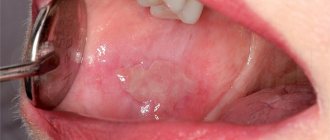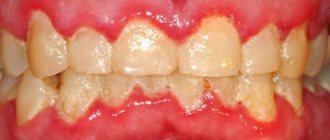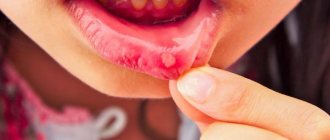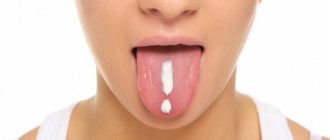What kind of pathology is this
Herpetic gingivitis is an inflammatory lesion of the gums caused by the introduction of a herpes viral infection into their mucosa. This infection is considered highly contagious and can be contracted anywhere, on the street and in public places. During the cold season, there are more cases of this infection. Its source is a sick person. Often this disease becomes a complication of viral stomatitis.
The virus is transmitted to children in the following ways:
- contact;
- household;
- airborne;
- hematogenous.
The first introduction of the virus into the baby’s body is manifested by gingivitis and stomatitis.
Preventive measures after illness
To minimize the risks of infection and relapse of the disease, it is important to adhere to simple hygiene rules. In order to prevent the manifestation of the herpes virus, experts advise taking the following precautions:
- brush your teeth regularly and rinse your mouth after eating, wash your hands more often,
- try to exclude accidental damage to the oral mucosa,
- lead a healthy lifestyle and eat right,
- use exclusively personal hygiene products and do not lend them to strangers,
- minimize contact with carriers of infection,
- Visit the dentist at least twice a year for preventative care.
Everyone should have their own personal toothbrush.
Once the virus enters the body, it remains in it forever. It hides in the nerve cells of the brain, remaining in an inactive state. Unfortunately, it is impossible to get rid of the infection forever, but we can do everything to prevent the activation of viral cells.
- According to WHO.
Causes
Often a child gets sick for the first time during teething. It prevents you from brushing the area where the tooth is erupting. As a result, infection accumulates in this place and inflammation of the gum tissue occurs, which gradually spreads. It is aggravated by frequent allergic reactions to introduced complementary foods.
In older children, pathology is provoked by the following reasons:
- mechanical microtraumas - damage to gum tissue occurs when brushing teeth with hard brushes or hard food when biting it;
- the introduction of herpes is provoked by other viral or infectious lesions of the oral cavity;
- the presence of polyps in the nasal cavity and breathing problems contribute to the penetration of an infectious agent into the gum tissue;
- an incorrect bite in a child leads to constant trauma to the mucous membrane and the development of inflammation;
- lack of nutrients, vitamins and microelements in the baby’s diet reduces local immunity;
- the manifestation of a viral infection is provoked by burns in the mouth;
- Dental diseases (caries, pulpitis) contribute to the development of the virus in the gum tissue, weakening local immunity.
The infection spreads to other tissues quite quickly, and isolated gum damage spreads to periodontal structures.
Possible complications.
More often, the disease passes without dangerous consequences for the patient. But with weak immunity, especially in young children, severe herpes sore throat can lead to serious complications caused by the spread of the virus to other organs:
- serous meningitis
- heart pain, myocarditis
- pyelonephritis
- encephalitis
- conjunctivitis.
To exclude the development of serous meningitis, you need to consult a neurologist; if you have heart complaints, you need to contact a pediatric cardiologist. If there are changes in the general urine test, you must make an appointment with a pediatric nephrologist.
With proper and effective treatment of herpes sore throat complicated by meningitis, the prognosis is usually favorable. But at the same time, the treatment of the youngest patients requires careful attention. With myocarditis the situation is more severe. Any complications of herpetic sore throat require the intervention of specialists!
Symptoms
Signs of herpes gingivitis in a child do not appear immediately after infection. Its latent period lasts up to eight days. The disease begins abruptly. At first, the baby becomes capricious, lethargic and restless. He sleeps poorly, refuses to eat, and complains of pain in his mouth.
After some time, the following manifestations of the disease appear:
- high temperature up to 39 degrees;
- increased salivation;
- gums become swollen and red;
- intergingival papillae increase;
- the oral mucosa is swollen;
- the tongue swells and becomes covered with a white coating;
- blistering rashes on the mucous membranes and skin around the mouth;
- nearby lymph nodes enlarge;
- headache;
- bad breath;
- general malaise;
- burning.
In place of the blisters, when they burst, ulcers appear that do not heal for a long time. All other manifestations disappear within a week, but they persist for up to fourteen days.
What does traditional medicine offer?
The appearance of blisters on the mucous membrane prompts some people to try to eliminate the symptoms of the disease on their own. Of course, some of the traditional medicine recipes are indeed effective as maintenance therapy, but they will never replace full treatment. The following tips can be highlighted from proven “grandmother’s” methods:
- rinsing with herbal decoctions - antiseptic, anti-inflammatory and antimicrobial. These are chamomile, celandine, sage, wormwood and lemon balm. The dried herb should be poured with boiling water and left until it cools completely. Then the resulting substance should be filtered and used for rinsing after each meal,
- ginger, tea tree and sea buckthorn oils - used to treat affected areas of the mucous membrane so that the wounds heal faster,
- cranberry - not only prevents the further spread of infection, but also increases the overall resistance of the body. The berries need to be poured with boiling water and left alone for a while. The resulting product can be used not only for rinsing the mouth, but also for oral administration.
Gargling with medicinal herbs will help in treatment.
It should be understood that any pharmaceutical product or traditional medicine recipe can only be used with the consent of a specialist. Attempts to get rid of the problem on your own in most cases lead to a worsening of the situation, especially when it comes to treating a child.
Diagnostics
The diagnosis of herpes gingivitis is quite easy for a child to make, since the disease has characteristic clinical manifestations. The diagnosis is made by the dentist based on an examination of the baby’s oral cavity and data on the course of the disease. Characteristic formations on the mucous membrane and manifestations of inflammation in the mouth clearly indicate that this is a specific lesion. To clarify the nature of the lesion, the doctor prescribes general blood and urine tests. If the disease is severe, it is necessary to clearly identify the type of pathogen. In this case, specific laboratory research methods are used.
These include:
- virological study;
- polymerase chain reaction;
- immunofluorescence method;
- HSV test for the determination of immunospot G-specific glycoprotein;
- serological test with immunoglobulin M.
These methods determine with a high degree of accuracy the type of pathogen in the blood and discharge from ulcers. But they are very expensive and labor-intensive, so they are used quite rarely.
Effective treatment of inflammation in the oral cavity
Thanks to the optimal combination of metronidazole and chlorhexidine, which are part of METROGYL DENTA®, the drug acts on the main pathogenic microorganisms that cause inflammation of the oral cavity. METROGYL DENTA® is intended for the treatment of most infectious and inflammatory diseases and the prevention of exacerbations. In periodontal practice, the use of METROGYL DENTA® is included in the complex treatment of gingivitis and periodontitis; in surgical dentistry, the drug is used to treat inflammation of the socket of an extracted tooth. In orthodontic practice, treatment of the oral cavity with METROGYL DENTA® relieves inflammatory phenomena when using dentures. The gel not only masks the symptoms of diseases, but acts on the cause itself - pathogenic microorganisms.
Up to contents
The information in this article is for reference only and does not replace professional advice from a doctor. To make a diagnosis and prescribe treatment, consult a qualified specialist.
Treatment
Treatment of mild forms of herpetic gingivitis in children is carried out on an outpatient basis under the supervision of a physician. In severe cases of the disease, the patient is hospitalized in a hospital. The patient is prescribed a diet with a predominance of pureed food that does not irritate the oral mucosa. It shouldn't be hot. There is no need to give your child solid food to prevent additional injury to the gums.
For mild forms, local treatment is used.
The following drugs are used:
- antiviral agents (Acicovir, Ganciclovir) - destroy the DNA of the virus, use ointment to lubricate the gums up to five times a day for two weeks;
- local anesthetic gels and ointments (Lidochlor gel, Kamistad) - they anesthetize, disinfect, have an anti-inflammatory effect, are used three times a day, two weeks;
- local antiseptics (Iodinol, Miramistin, Hexoral) - these agents rinse the mouth every four hours, two weeks;
- reparative preparations (Solcoseryl-gel, Methyluracil ointment) - applying ointments to ulcers promotes their epithelization and rapid healing, applied three times a day for two weeks.
Herbal infusions (chamomile, rose hips, calendula, sage, St. John's wort, licorice) are widely used for rinsing when gums are damaged.
In severe cases, the baby is prescribed oral medications.
The following drugs are prescribed:
- antiviral drugs (Famciclovir, Acyclovir, Zovirax) - taken according to the regimen prescribed by the doctor, the drug must be taken to the end, otherwise there will be a relapse;
- antihistamines (Suprastin, Tavegil, Citrine) - reduce swelling of gum tissue and reduce pain;
- antipyretics (Panadol, Nurofen) are used to reduce high fever.
Parents should monitor the baby’s oral hygiene; during illness, it is carried out especially carefully. To prevent gum injury, it is recommended to use toothbrushes with soft bristles. It is necessary to treat toys and objects that the baby uses with antiseptics.
How to treat herpetic stomatitis?
Treatment of herpetic stomatitis in children and adults can be general or local. The therapeutic treatment strategy is determined by the form and severity of the disease. In this case, the patient is usually shown:
- high-calorie diet, drinking plenty of fluids, bed rest;
- antiviral drugs (orally, intravenously or intramuscularly);
- restorative therapy (taking vitamins);
- symptomatic treatment (use of antipyretics, painkillers, anti-inflammatory drugs);
- local therapy (rinses, applications, etc.).
When choosing tactics for treating acute or chronic herpetic stomatitis in adults and children, it is important to correctly determine the form and stage of the disease. That is why experts urge patients not to self-medicate, but to immediately consult a doctor if signs of damage appear.
Therapy under the supervision of a specialist will allow you to recover quickly and without consequences for the body. With the right approach, herpes stomatitis in a child or adult can be cured in 10-14 days.
Types of disease in children
There are 80 types of herpes virus, of which 8 are dangerous to humans. The nature of the disease and the type of herpetic rash depend on the type of herpes simplex virus (HSV):
- Type 1 HSV - looks like cold-like rashes in the form of blisters on the lips, causes herpetic stomatitis and herpetic encephalitis.
- Type 2 HSV – manifests itself as a rash on the genitals (genital herpes).
- Type 3 HSV – causes chickenpox and recurrent herpes zoster.
- The 4th type of HSV - Epshane-Barr virus, causes malignant lymphoma and infectious mononucleosis - an acute viral disease with fever, damage to the respiratory tract, lymph nodes, liver, spleen and blood.
- Type 5 HSV – cytomegalovirus; affects the respiratory system, internal organs, intestines, eyes, brain, nervous and urinary systems.
- Type 6 HSV - causes viral eczema - exanthema - pseudorubella-type rash;
- The 7th and 8th types of HSV have not been sufficiently studied. Source: A.G. Lateral Herpesvirus infections in children - an urgent problem of modern clinical practice // Children's infections, 2010, No. 2, pp. 3-7
Cytomegalovirus infection
Cytomegalovirus infection is characterized by the formation of giant cells and specific infiltrates in the affected organs, a latent (asymptomatic) course in individuals with a normal immune system and with clinical manifestations in immunodeficiency states, mainly in young children.
Clinical forms of cytomegalovirus infection (CMVI):>
Congenital CMV infection is infection from the mother during pregnancy and childbirth and acquired, which is often asymptomatic. The full clinical picture of CMV infection is characterized by:
- increase in body temperature;
- lethargy;
- drowsiness;
- adynamia;
- enlarged lymph nodes, liver, spleen, salivary glands;
- rash;
- other organs are involved (lungs, kidneys, central nervous system).
The disease has an undulating, relapsing course, reminiscent of the clinical picture of infectious mononucleosis.
Virus activity
Most often, children are faced with the herpes simplex virus, which manifests itself in the form of that same cold on the lips.
Herpes on the lips or chickenpox are not as dangerous for a child as herpetic lesions of the eyes, genitals, and internal organs.
Externally, herpes appears as a rash on the skin or mucous membranes. It usually looks like small blisters that eventually burst and become sores. In addition to the rash, there is burning and itching.
How often the herpes virus is activated is influenced by hereditary predisposition and the state of the immune system. The weaker the child’s immunity, the more susceptible he is to virus attacks.
Newborns up to 1 year of age are protected by maternal antibodies. The peak incidence is observed at the age of 2-3 years. By the age of 15, up to 90% of adolescents are infected with HSV. The pathogen is in an inactive state in the body and does not cause discomfort. Under unfavorable conditions, HSV is activated. Source: A. Taieb, N. Diris, F. Boralevu, C. Labreze Herpes simplex in children. Clinical manifestations, diagnostic value of clinical signs, clinical course // Ann Dermatol Venerol, 2002, v.129, No. 4, p.603—608
Causes of exacerbations and relapses of herpes in children:
- decreased immunity due to severe and prolonged illnesses;
- severe shocks and chronic stress;
- systematic fatigue;
- hypothermia;
- taking hormonal medications;
- endocrine pathologies;
- hormonal changes in adolescence;
- systematic unbalanced diet;
- complicated seasonal colds;
- chemical and radiation anticancer therapy;
- excessive physical activity. Source: M.N. Kankasova, O.G. Mokhova, O.S. Pozdeeva Frequently ill children: the view of an infectious disease specialist // Practical Medicine, 2014, No. 9(85), pp. 67-71







